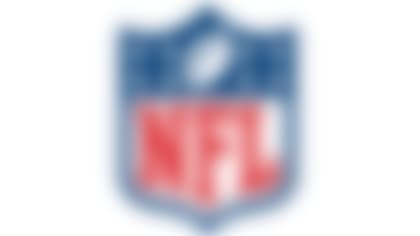In case you haven't noticed, there is a special-teams coverage crisis in the NFL.
Kick returns aren't just routinely going for long gains. They are routinely going the distance.
Consider:
» At least one touchdown has been scored on a return in each of the first five weeks of the season. It's the most successive weeks that that has happened since 1950.
» The nine touchdowns scored on kick returns this season ties for the most through the first five weeks since 1950. New England's Brandon Tate and Seattle's Leon Washington have each taken two kickoffs to the end zone.
The trend has drawn some exasperated responses from around the NFL.
"Those numbers are kind of high," Chicago Bears special teams coach Dave Toub said. "Since 1950? That's amazing."
There are no simple explanations, although some current and former special teams coaches -- along with arguably the best cover man in the game's history -- have their theories.
The most popular is that colleges are producing more top-flight returners, and NFL clubs have put a greater premium on having them. The Buffalo Bills made C.J. Spiller their first-round pick last April to presumably become their top running back, but so far his most notable play was a 95-yard kickoff return for a touchdown against New England. Another rookie running back, Kansas City Chiefs second-rounder Dexter McCluster, returned a punt a team-record 94 yards for a touchdown against San Diego.
It is widely believed that the spectacular returns by Chicago's Devin Hester in 2006 and 2007, his first two seasons after the Bears made him a second-round draft pick from Miami, and the big contract that followed, did plenty to glamorize the role of the returner. It encouraged players with such skills to pursue that role with the idea that it could be a surefire path to NFL success. Hester, who has returned a punt for a touchdown this season, had a combined 11 scores on returns (seven punts, four kickoffs) in '06 and '07.
"We proved it a long time ago with Devin, how you can win games with that, and I think a lot of teams are going towards that," Toub said. "It's not just like a secondary thing that a wide receiver or defensive back would do on the side. It's a specialty, and guys are making a lot of money doing it.
"The talent is so much better coming out. When you're watching (college) returners now, you're wondering, 'Is this guy a blue?' That's what we call a difference-maker. I've seen so many of those guys these past few years because there are more of them coming out."
The problem for multiple NFL teams, however, is that they don't have anything approaching similar talent within their coverage units.
The majority of those players are reserves from the lower portion of the roster, so they tend to lack the speed and athleticism of those near the top. And, because they carry the lowest salaries, most are rookies. Despite their inability to crack the starting lineup in the NFL, they were stars on their respective collegiate teams, meaning they've had little or no kick-coverage experience because stars generally don't have that duty.
"There's so much turnover in special teams every year now because almost every draft pick makes the team," Philadelphia Eagles special teams coordinator Bobby April said. "And he replaces the bottom part of your roster, so consequently, you're getting rid of good special-teams players. Take Buffalo (where April spent the previous six seasons and consistently had one of the best special-teams units in the NFL), for instance. How many good special-teams players did we let go every year? A lot."
Given that football priorities are unlikely to change, with the greatest investment of money and time always going to front-line position players (with backups serving as practice opponents to help prepare them for each game), the rag-tag complexion of kickoff- and punt-coverage units figure to stay the same.
"You can get a whole team full of special-teams players … and not win a football game," Toub said. "You have to build your team from the offense and defense out, and then try to be as fundamentally sound as you can on the back end on special teams. That's the way that you win."
Still, repeated fundamental mistakes in coverage have given way to a weekly avalanche of game-breaking returns, including those that don't go the distance but provide excellent field position.
Steve Tasker, widely viewed as a Hall-of-Fame candidate for his long and distinguished career of covering kicks for the Bills, sees basic errors all of the time when watching games as a color analyst for CBS Sports.
"It's the same old story," Tasker said. "You get guys avoiding blocks in the wrong direction. You kick the ball to the best guy on the field, with some space on the kickoff. Then, he picks the other side that the coverage avoids, and he springs it loose. It's not rocket science, but you've got to do it right."
Too often, Tasker sees it being done wrong because cover men aren't approaching the job with the proper mindset. Rather than looking to cover a kick as a team, where the main focus is on containment to minimize return yardage, Tasker says they each seek to deliver the big hit that will make highlight clips. "And when they don't," Tasker said, "they just expect that somebody else will get it."
It was widely assumed that the league's decision last year to outlaw the formation of a three-man blocking wedge as the returner fields the ball on kickoffs might actually reduce the number of long returns. The measure was taken to help reduce injuries occurring when cover men, especially the one designated as a "wedge buster," collided with the players who formed the wedge.
However, because of the difficulty of enforcement, some teams are known to be getting around the rule and might, in fact, be providing even more effective blocking as a result. It might be a penalty to have more than two blockers in front of the return man as he catches the ball, but nothing says three or more can't move in front of him soon thereafter.
"I think guys are pushing the limit," said one special-teams coach, who requested anonymity. "I knew, when they made that rule, that it was going to be hard to officiate because of the moving parts involved. The only time they're enforcing it is before anything happens. When you first catch the ball, is there a wedge or isn't there a wedge? There's no contact made at that point. But then you start moving and then the guys are coming down the field. Now the contact's being made and there's no call being made because (the officials) can't tell whether it was designed that way or did it just end up that way? It's such a gray area for the officials.
"I see some teams that are trying abide by the rules and they're using two men, and then they have a bunch of other single blocks, which is the whole intent of the rule. I also see some that are using two two-man wedges and then, all of a sudden, they end up being a lot closer together than they initially started. To me, sometimes it looks like a four-man wedge."
Some teams have also taken to using more athletic large players to block for returns. Instead of linemen, who offer plenty of size but aren't usually that nimble, they're going with more tight ends and fullbacks. The Eagles, for instance, are using 6-foot-1, 235-pound tight end Garrett Mills and used 6-foot, 225-pound running back Mike Bell (before he was traded to Cleveland) as blockers.
The wisdom of that strategy, however, hasn't stopped the Philadelphia media from harshly criticizing April for the team's poor coverage on kickoffs and punts. As far as they are concerned, the results haven't justified the fanfare prompted by his hiring.
April attributes at least part of the problem to the players' unfamiliarity with some of his concepts. There is plenty of time for that to change.
"Teams typically get better at covering as the year goes on," Toub said. "You kind of iron out the mistakes."
Nevertheless, Pro Football Hall of Fame coach Marv Levy, who began his NFL career as one of the league's first special teams coaches when he joined the Eagles in 1969, doesn't see any excuse for special teams coverage to be as bad as it has been through the first five weeks of the season. He also doesn't view what has happened so far as an aberration. He maintains that it is something that continually, and inexcusably, runs rampant in the NFL.
"I think plenty of lip service is given to the importance of the special teams, but I do not believe that the attention (coaches) claim to be giving is being given," Levy said. "I've seen some head coaches at the end of practice, when you're working on some aspect of the special teams, walk off the field. They're going in for something more important; they've got to watch some tape or something else. I've seen it on many occasions, and it just stuns me."
Tasker recalls that Levy, his head coach in Buffalo, sat in the front row of every special-teams meeting conducted by special-teams coach Bruce DeHaven.
"That says a lot," Tasker said. "Some head coaches don't do that, and it trickles down. Players get the idea that special teams don't count and it's kind of a throwaway, and it costs their teams. Look at San Diego."
Special-teams gaffes have played a major role in the Chargers stumbling to a 2-3 start. Two weeks after allowing McCluster to score on a punt return, the Chargers gave up back-to-back kickoff returns for touchdowns by the Seahawks' Washington (think they miss Pro Bowl cover man Kassim Osgood right now?). Last Sunday, the Oakland Raiders blocked back-to-back punts by Mike Scifres, recovering the first for a safety, helping them to snap a 13-game losing streak to San Diego.
In Week 4, the Miami Dolphins experienced a special-teams meltdown of their own in prime time during a 41-14 loss to New England on Monday Night Football. With the Patriots trailing 7-6 at halftime, Tate broke the game open by returning the second-half kickoff 103 yards for a touchdown. Patrick Chung later blocked a punt to set up another touchdown, and then blocked a field goal that Kyle Arrington returned for a score. The next day, the Dolphins fired special teams coach John Bonamego.
The New Orleans Saints benched kicker Garrett Hartley after he missed a 29-yard field goal in overtime against the Atlanta Falcons, whose kicker, Matt Bryant, nailed a 46-yarder to win the game. So much for Hartley's heroics in helping the Saints to reach the Super Bowl. And so much for designations of leadership. In August, after they gave up three kickoff returns of 50-plus yards and a 40-yard punt return in the first two preseason games, the Saints released special teams captain Troy Evans.
Taking extreme steps to fix special-teams problems makes sense, particularly during a season ruled by parity. With so little separating many teams, special teams figure to often make the difference, as has frequently been the case thus far.
"If the kicking teams are one third of the game -- everybody says it, although not many people believe it -- then an opportunity is being missed to not excel there," Levy said. "I think a team that really excels in the kicking game is going to be in the playoffs, and they're going to be right in the mix for the top goal."
That would be winning the Super Bowl, the game the Saints won last year in no small part because of a huge momentum swing caused by their recovery of a surprise onside kick to start the second half.
Follow me on Twitter @viccarucci



